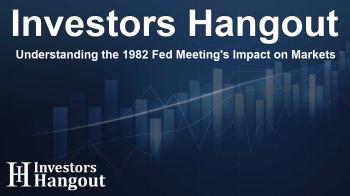Understanding the 1982 Fed Meeting's Impact on Markets

The Significant 1982 Fed Meeting at Jackson Hole
The eventful summer of 1982 marked a dramatic turnaround in America's economic landscape, driven by a pivotal Federal Reserve meeting in Jackson Hole. This symposium represented the gathering of influential central bankers and economists who were grappling with the lingering effects of high inflation and recession. President Nixon's earlier decision to devalue the dollar had long-lasting repercussions, with inflation peaking at an alarming rate, reminding policymakers of the delicate nature of monetary economics.
Fed Chair Paul Volcker, who took charge in 1979, faced the nation's economic turmoil with bold measures. By 1982, he had raised interest rates aggressively, pushing the Fed funds rate above 20% in a bid to curb rising inflation. His strategy was viewed as painful but necessary; however, it also brought the economy to its knees, ushering in a deep recession. This meeting at Jackson Hole was tantamount to a turning point, aiming to instill confidence in a faltering market.
Pivotal Moments in Jackson Hole's History
Reflecting on the richness of the Jackson Hole gatherings, 1982 stands out. This was the first time the symposium was held at this scenic venue, selected partly for Volcker’s love of fly fishing. Since then, this meeting has been a stage for significant announcements, including renowned changes in monetary policy and strategies. It was here that later Fed Chairs announced various rounds of quantitative easing (QE), reshaping financial markets and bailouts throughout the late 2000s.
The Transition from Stagflation to Recovery
The term 'stagflation' hung heavily over the economy during the late 1970s and early 1980s, as inflation and stagnation turned the American dream into a nightmare for many. However, in August 1982, a critical shift occurred. Volcker's approach began to pivot; he started lowering rates as deflation began to rear its head. The move to ease the Discount Rate was the first step toward revitalizing both consumer and investor confidence.
Understanding the Economic Context
The landscape of the economy at that time was daunting—industrial production was declining, many banks failed, and unemployment soared. However, this backdrop of economic malaise allowed Volcker to take the necessary actions to promote liquidity in the markets. Economic indicators painted a bleak picture: durable goods orders dropped, raw production fell for consecutive months, and historic highs in interest rates stunted growth opportunities.
Yet, as history has shown, the Fed's decisive moves would lead to a gradual recovery. By 1985, the dollar regained strength, demonstrating a remarkable turnaround in economic resilience.
The Enduring Legacy of the 1982 Meeting
The changes initiated in 1982 resonated through the years, creating the conditions necessary for one of the longest bull markets in American history. The decisions made in Jackson Hole not only shaped the immediate economic policies but also set a precedent for future Fed actions. Many analysts and market participants who anticipated a dramatic downturn were surprised as the landscape shifted toward recovery.
Lessons Learned
Critiques of the Fed’s actions point to the fundamental lesson that during times of economic distress, the instinct to tighten can often exacerbate problems rather than solve them. The profound realization that emerged was that economic conditions require a thoughtful balance between control measures and stimulus initiatives. This meeting showcased the Fed's role in steering markets through turbulence, and how, by learning from the past, they could navigate a path forward.
Frequently Asked Questions
What was the significance of the Jackson Hole meeting in 1982?
The 1982 Jackson Hole meeting was a pivotal event where Paul Volcker started to lower interest rates, marking the beginning of economic recovery from stagflation.
How did Fed policies influence the markets during this period?
Fed policies, particularly the lowering of interest rates, helped restore liquidity in the market, leading to increased confidence among consumers and investors.
What was the outcome of the decisions made during the 1982 meeting?
The outcome was a prolonged bull market, with stock prices rising significantly, demonstrating resilience in the U.S. economy.
How did the 1982 meeting compare to other Jackson Hole meetings?
This meeting was groundbreaking as it marked a shift in monetary policy approach, paving the way for future meetings focused on easing and recovery strategies.
What lessons can we learn from the 1982 economic situation?
The key lesson is that during economic crises, expanding liquidity rather than tightening financial conditions often leads to recovery and growth.
About The Author
Contact Riley Hayes privately here. Or send an email with ATTN: Riley Hayes as the subject to contact@investorshangout.com.
About Investors Hangout
Investors Hangout is a leading online stock forum for financial discussion and learning, offering a wide range of free tools and resources. It draws in traders of all levels, who exchange market knowledge, investigate trading tactics, and keep an eye on industry developments in real time. Featuring financial articles, stock message boards, quotes, charts, company profiles, and live news updates. Through cooperative learning and a wealth of informational resources, it helps users from novices creating their first portfolios to experts honing their techniques. Join Investors Hangout today: https://investorshangout.com/
The content of this article is based on factual, publicly available information and does not represent legal, financial, or investment advice. Investors Hangout does not offer financial advice, and the author is not a licensed financial advisor. Consult a qualified advisor before making any financial or investment decisions based on this article. This article should not be considered advice to purchase, sell, or hold any securities or other investments. If any of the material provided here is inaccurate, please contact us for corrections.

